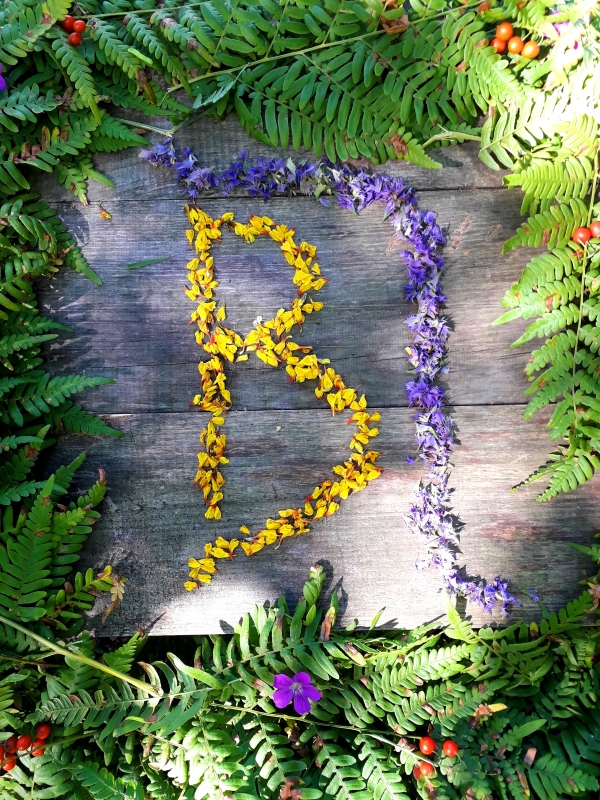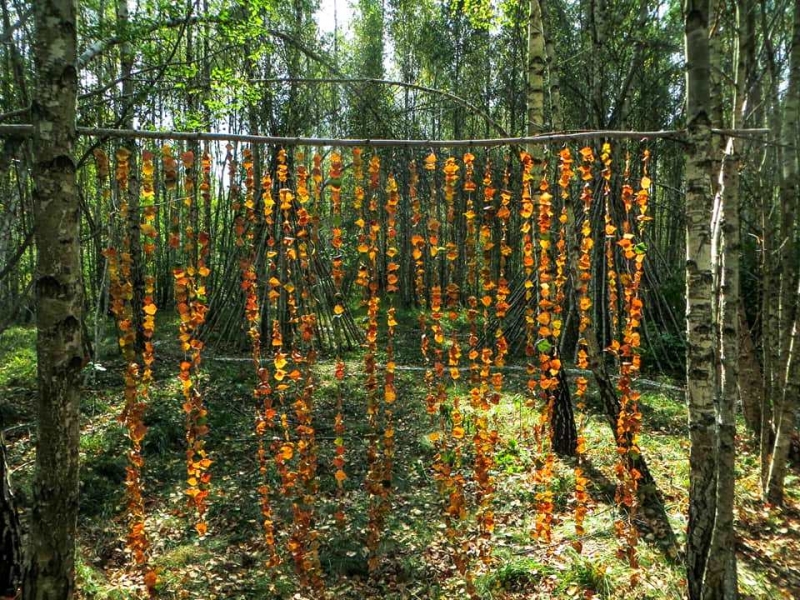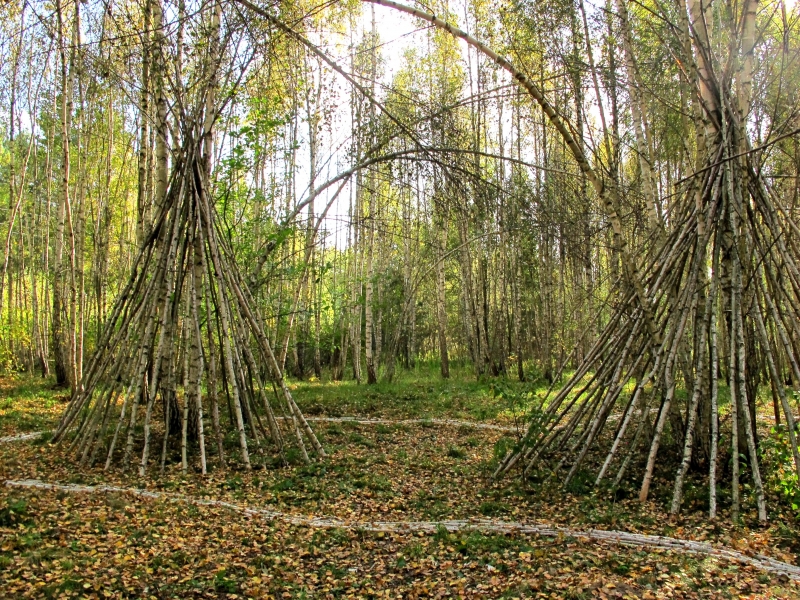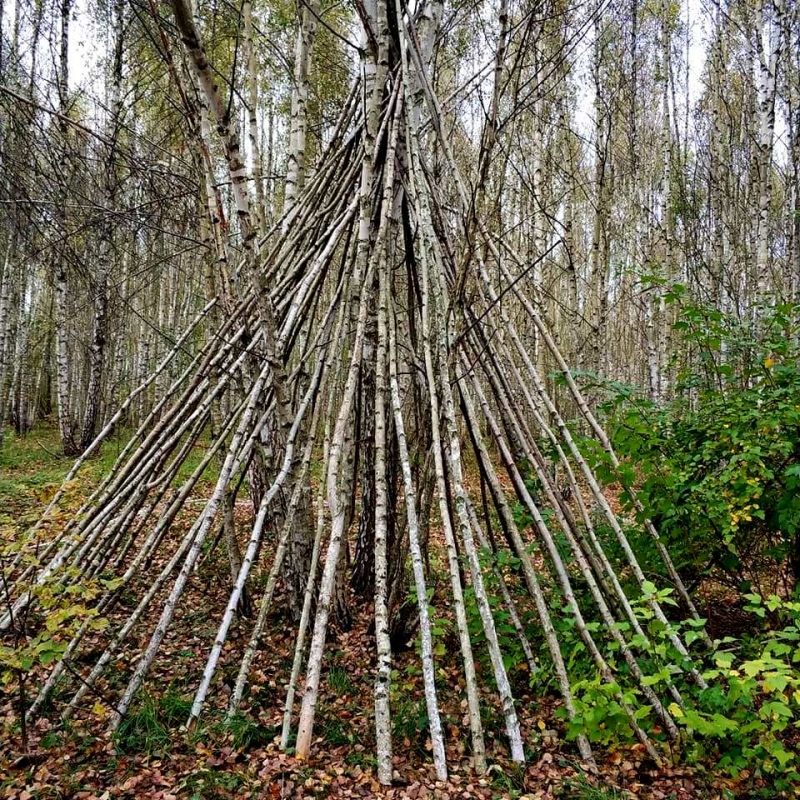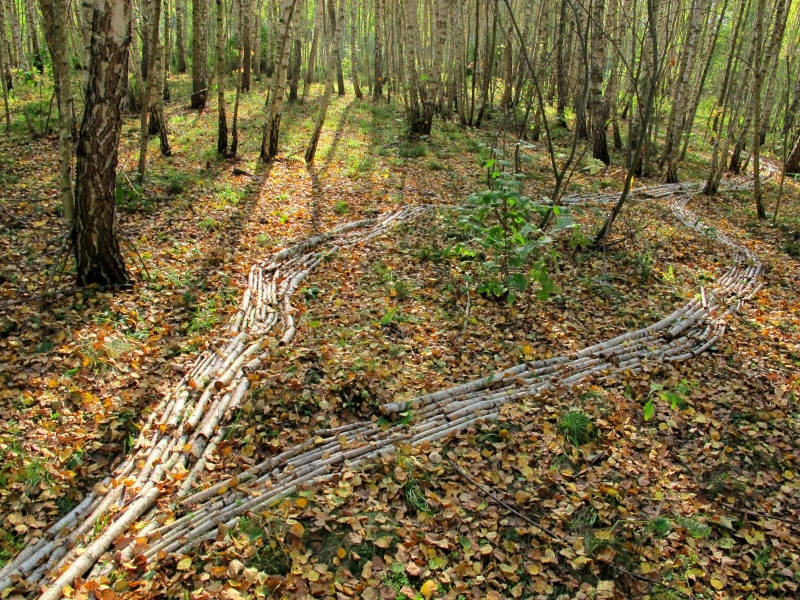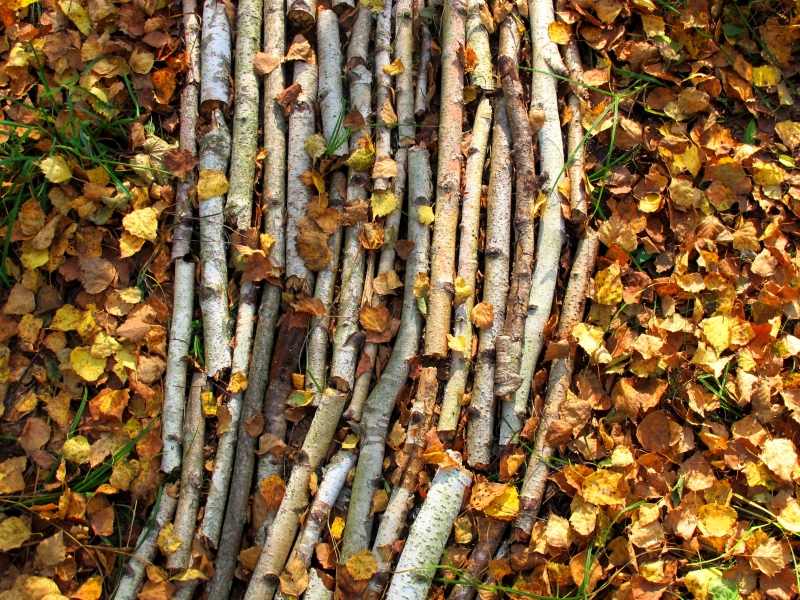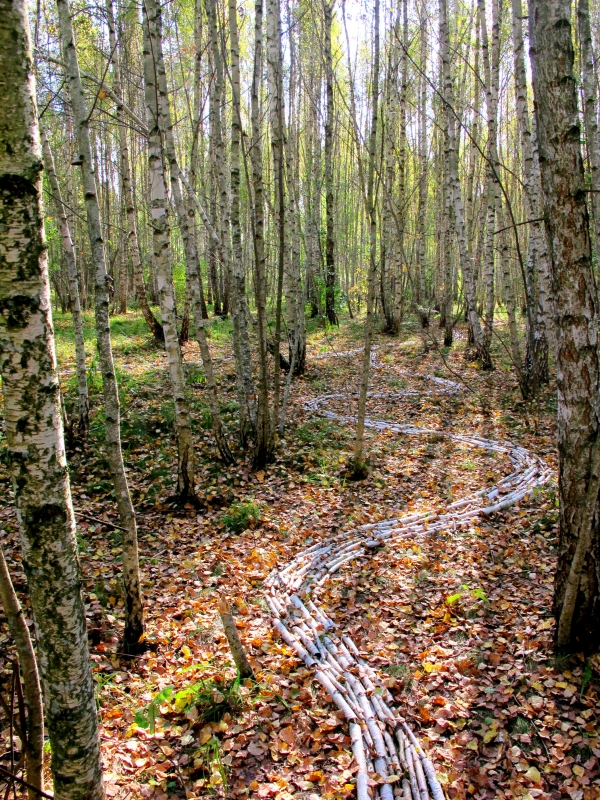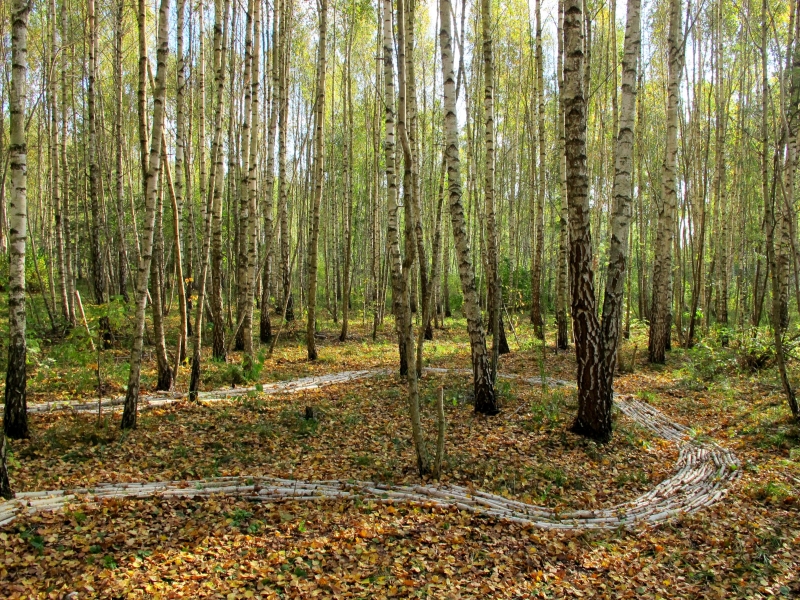BENJAMIN LAMBLIN
THE FOREST FLOWS THROUGH THE FOREST (2019)
Benjamin Lamblin est étudiant à l’Ecole du Louvre et effectue un stage au musée POLENOVO lorsqu’il prend l’initiative de valoriser une partie de la réserve naturelle du musée en y faisant s’épanouir l’installation « The forest flows through the forest ». Inspirée du Land Art, avec des moyens minimalistes, feuilles ou branches, Benjamin Lamblin met en valeur le bouleau – arbre qui lui évoque le plus la Russie – en en faisait son matériaux principal. C’est par là même un moyen de rendre hommage à la nature que peignit Vassily Polenov. La première pensée du projet n’atteignait pas les proportions du travail final, mais partait de la mise en forme – par divertissement – du monogramme de Vassily Polenov à l’aide de fleurs, et surtout de la volonté de créer un prototype d’atelier participatif pour les visiteurs au sein du parc naturel du musée, assez peu exploité lors des workshop. Le projet, finalement exécuté en solitaire et sans que le personnel du musée ne soit mis au courant, prend une envergure non négligeable et se développe dans une autre direction, sur des fondements esthétiques, pittoresques et poétiques plus que conceptuels ou participatifs.
Entre le 21 août et le 7 septembre, à raison d’une heure trente à trois heures par jour, Benjamin Lamblin dispose des bouts de bois morts qui tracent un chemin sinueux entre les arbres et sur plusieurs mètres. A l’une de ses extrémités sont assemblées de grandes branches de manière à former deux structures coniques. Ainsi disposées, ces huttes évoquent un campement, agrémenté d’une structure légère en guirlandes de feuilles et d’un foyer fait de brindilles et de rondins.
D’abord pensée pour être regardée d’un point de vue unique, l’installation prend une tournure plus immersive : un large ruban blanc de branches de bouleaux qui sillonne le bois et y évolue à la manière d’une racine ou d’un cours d’eau, et dont le bout s’effiloche pour prendre fin. Ce sentier devient la colonne vertébrale à partir de laquelle plusieurs recoins du bois sont complétés et valorisés. L’ensemble entend mettre en lumière l’aspect pittoresque de la forêt. Son caractère ornemental se fonde sur la verticalité des boulots aux troncs fins et sans branches basses, qui contraste avec la sinuosité et l’horizontalité du sentier. Ce dernier, qui serpente comme un ruisseau, complète le paysage d’un cours d’eau et lui confère une tournure plus bucolique. Le rideau de feuille, animé par le vent et la lumière, signe quant à lui le point final du parcours.
La partie anthropisée et flanquée des deux huttes s’interprète de manière équivoque, tantôt comme un campement, tantôt comme un sanctuaire. Outre l’aspect esthétique, cet endroit est volontairement plus spirituel et compose une ode à la nature, en venant rappeler que la motivation de Vassily Polenov, lorsqu’il s’installa dans la campagne de Taroussa, était d’être au contact du paysage russe. Au centre de ce temple, le foyer de brindilles noires auréolées de rayons de rondins blancs évoque une éclipse solaire, symbole des forces de cette nature. Il est amusant de noter que les employés, lorsqu’il ont découvert l’installation par eux même, sont restés perplexes au point de penser qu’une secte y avait exécuté un rituel dédié au solstice.
L’installation s’inscrit dans un processus de création, en partie renseigné dans un journal de bord qu’a tenu Benjamin Lamblin en espagnol, et évolue sur la durée: si sa mise en place met plusieurs jours, le choix des matériaux fait qu’elle se dégrade en peu de temps à l’approche de l’automne. Le rideau de feuilles du campement se délite rapidement, les branches pourrissent, les feuilles mortes recouvrent le ruisseau et des champignons s’y intercalent : sa fragilité en fait une œuvre éphémère dont on ne conserve aujourd’hui que des photographies.
Clémence Despinois pour l’association Vassily Polenov
Des extraits du journal de bord, traduit de l’espagnol vers l’anglais par Benjamin Lamblin :
August 21th, 2019:
[…] I wanted to create something on my own. I had just seen a documentary about the birth of Land Art in the United States during the sixties and was kind of amazed by their work even knowing them already. I also felt like giving shape to my feelings and ideas. However, I didn’t pretend to work on deep conceptual thoughts like they did. My goal was to create something beautiful for the eyes. I started to wander around the estate to find a spot and things to put together. It didn’t really work out at first. Later on the same day, I went to the birch forest near the Gorod Masterov, a beautiful place out of the main paths of the park. The whole wood is filled with the white vertical lines of the birches and the lighting is great, especially during the sunset. I knew I could work there without anyone knowing. I then gathered pieces of dead wood – there were so many of them – and started to draw a circle with them. I quickly realised the circle had to become something bigger, so instead of closing it, I extended it in order to create a stream of white wood which was flowing across the
birches. I felt like this stream was completing the small landscape. The water is such an important part of the Russian nature so it came as a reminder and also helped breaking the monotony of the vertical white lines. The little gaps between each of the wooden pieces actually recreate the rhythm of a flowing stream – even if time-frozen. It is a skeleton, a print, a memory of what was and isn’t anymore. […] I was very excited thinking about the next steps of the work. I had many ideas coming through but I also knew they were most likely to change a couple of times before actually becoming real.
August 22th, 2019:
At that point, I had defined a point of view from which the whole creation had to be seen: it was thought as a theatre set or as a painting. It was much easier to start this way rather than using the stream as a road to different points of interest. But I need to create a few anyway. I was considering some options of sculptures: altar, egg … We will see as it goes. I kept on collecting wood for the stream anyway, using thick trunks for the back part in order to a consistent visual effect in a limited amount of time. During the evening, I looked for works using wood to draw inside forests and I found a project of the year 1995, made by the Danish artist Mikael Hansen: Organic Highway. Mine is very similar, except the scale is much smaller.
August 23th, 2019:
It was clear that I had to work faster because the forest was not on my side. The summer was ending and the leaves were already falling one by one, slowly covering the stream and cleaning them off would take too much time. […]
August 24th, 2019:
I tried to create a half sphere with wood pieces but it definitely failed. It ended up being a flat circle. It was almost a campfire which would have been left by a tribe. I myself left it and might come later to make a new stuff out of it: for example a circle pattern that could repeat itself along the stream. […] While I was gathering more and more wood, I discovered a great spot that was just aside my construction. There are three bending birches that create beautiful arcs. The space could be converted into a more impacting theatre set than my first one. I thought about curtains made out of leaves to decorate the birches but it might be tricky in terms of material (thread) and installation. Maybe I would be able to set the curtains on other birches near the bending ones. Then I had to extend the stream to connect it to this newly discovered area. The gap was still quite big and therefore variations would be necessary to avoid monotony on the stream. […] During the afternoon, I gathered leaves around the Gorod Masterov so I could start making the curtains in my room.
August 25th, 2019:
Already three curtains were done.
August 26th, 2019:
I was still crafting the curtains in my room and I also visited the birch forest to see again how to set them. Unfortunately, I broke the branch I chose as the main support. Then I found another spot but the gap between the two birches was bigger: we will need more curtains, maybe thirty.
August 27th, 2019:
My project for the new theatre set was now going toward a shamanic sanctuary. I wanted to close it with very long trunks (whole trees that fell down, there were many) put on the birches, continue the stream inside the temple and an eclipse symbol in the middle.
August 28th, 2019:
I did thirty curtains and I set one in the sanctuary to see if it resists. I will see that when I return from Moscow.
August 31th, 2019:
I hadn’t been there for a few days and the wood was becoming more and more beautiful thanks to the falling leaves. I was very happy to see that the lone curtain of leaves resisted during my absence. I will be able to install them sooner than expected. Using very long trunks, I created a giant grid/fence around the sanctuary – actually on one side. The diagonals create a lot of confusion with the vertical lines of the trees and I hope it will bring the attention to the door and its curtains of leaves that will take place in the middle. To close the other side of the temple, I will build two big tipi around two different birches also using huge trunks gathered here and there. These two structures will define the rotation of the stream later.
September 1st, 2019:
It was now clear that the whole project was no more a theatre set but a tiny landscape that could be explored wandering around.
September 2nd, 2019:
I drew the lines of the new part of the stream, they are pretty much organic.
September 4 th , 2019:
The thirty curtains of leaves have been set up. I could tell it was going be extremely ephemery since the wind was quickly knotting them all together. The very first part of the stream was shaped as a delta of a river and also as converging roots, with big and irregular pieces of wood. It was a good way to give a start to the whole path created by the stream.
September 6 th , 2019:
The very last touch was the creation of the eclipse symbol before the door of the sanctuary mixing thick white wood and tiny dark branches. It represents the forces of Nature – the ones that are celebrated inside this temple.
September 7 th , 2019:
Cleaning and Pictures.




